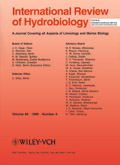| Internat. Rev. Hydrobiol. | 85 | 2000 | 1 | 5-23 |
|
Daniel Hering 1,
Jochem Kail 2,
Sabine Eckert 3,
Marc Gerhard 4, Elisabeth I. Meyer 5, Michael Mutz 6, Michael Reich 4, Ilga Weiss 2 |
|
1Institute of Ecology, Faculty of Hydrobiology, University of Essen, Universitätsstr. 5, D-45117 Essen, Germany 2Geographical Institute, Friedrich-Wilhelms-University Bonn, Meckenheimer Allee 166, D-53115 Bonn, Germany 3Institute of Water Resources Management, Hydraulic and Rural Engineering, University of Karlsruhe, Kaiserstr. 12, D-76131 Karlsruhe, Germany 4Department of Landscape Planning and Nature Conservation, University of Hannover, Herrenhäuser Str. 2, D-30419 Hannover, Germany 5Department of Limnology, Zoological Institute, University of Münster, Hüfferstr. 1, D-48149 Münster, Germany 6Brandenburg Technical University Cottbus, Research Station Bad Saarow, Seestr. 45, D-15526 Bad Saarow, Germany |
| Coarse Woody Debris Quantity and Distribution in Central European Stream |
| key words: coarse woody debris; Central Europe; stream management; riparian forest |
| Abstract |
| Summarized here are ten investigations concerning the volume of coarse woody debris (CWD) in Central European streams. Altogether, 69 stream sections were examined ranging from Northern German lowland streams to brooks in alpine regions. Most of the study streams are according to Central European standards quasi-natural and are bordered by deciduous forest. |
| The geometric mean of CWD volume related to stream length is 1.44 m3 /100 meter reach. Related to stream bottom area, the geometric mean of CWD volume is 0.202 m3 /100 m2. The mean number of logs ( dimeter >10 cm diameter) is 12.5 logs/100 meter reach, and 3.01/100 m2 bottom area (geometric means). Regarding only quasi-natural stream sections (riparian forest currently unmanaged and no removal of CWD for at least 10 years), the geometric mean of CWD standing stock is 0.45 m3 /100 m2 for lowland streams, 0.38 m3/100 m2 for streams in lower mountainous areas and 0.02 m3 /100 m2 for alpine floodplains. |
| From the distribution of size classes and comparison with other studies it is likely, that the current CWD standing stock is considerably less than the potential amount of CWD. For centuries all of the streams have been influenced by man. Historic alterations of the stream, its floodplain and the riparian vegetation may still affect CWD supply and standing stock. We conclude that virtually all streams in Central Europe are highly altered with respect to the amount of CWD, and that the importance of CWD is under-represented in recent assessment principles for streams in Germany. |
| 4 present adress |  |
|
|
[Startseite]
[Sitemap] [english] |